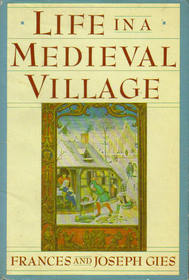Widely-recognized researchers Frances and Joseph Gies have done the improbable. They have created life in Elton, in the 1300s. This is in the English East Midlands. Because there weren't many luxuries to be purchased in that early world, people showed their largesse by inviting others to partake of a meal. A host's abundance was demonstrated in what he served his guests to eat and drink.
The authors go to great pains to show just how the poor and the rich lived and ate in the Middle Ages. I was unaware that the lord owned the milling process and everyone had to pay him for grinding their wheat and other grains. That's why the serfs ate so much porridge; it didn't need to be ground (keeping their pennies out of the landlord's pockets). In poor homes, the children had pallets on the floor and the parents had a bed up in the loft. The baby might sleep with them, or in a cradle nearby.
Since the water was suspect, people brewed their own beer. In fact, you could be arrested for offering a crummy product. These folks certainly understood product quality. Early on, the authors discussed the Domesday Book and the incredible accounting involved. In fact, according to the Giese's, a village was like a well-oiled machine; everyone had a job and responsibilities were clearly outlined.
How the village churches were financed was quite interesting. The charges were small and often given "in-kind" (as grain or other foodstuffs). During the Middle Ages, tithing (giving 10% of one's income each year) from the Bible, came into force. Chastity in clerics in the 1300s was a goal, not necessarily attained. Most were married or had concubines.
The next area of interest was the law and how it was handled in Elton. The goal was social harmony and those who did not follow through with that harmony were dealt with by the manorial courts. Most of the discussion here was spent on the legal courts but there were others. The Church Court dealt with canon law and marriage problems of the laity or clergy. The Royal Court dealt with the common law, as outlined by the Anglo-Saxon and Norman rulers.




